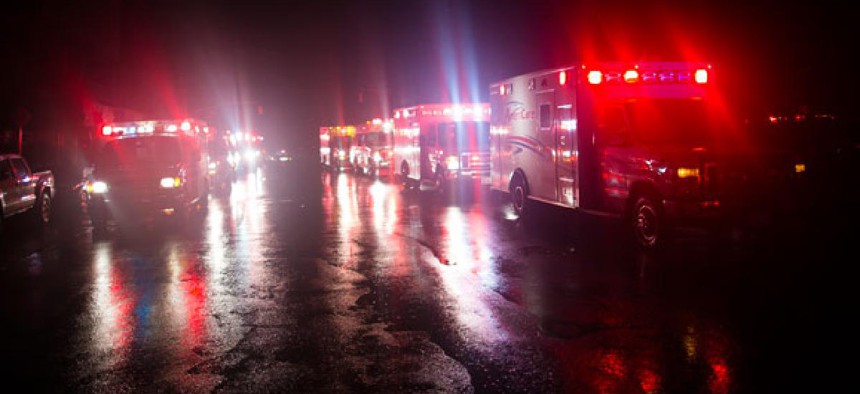Natural disasters become battlegrounds in spectrum fight

Ambulances wait outside New York University Tisch Hospital during the storm. John Minchillo/AP
Both broadcasters and wireless companies are quick to insist that they’re not interested in exploiting disasters for political and commercial gain.
While the government seeks to parcel out valuable spectrum to new technologies, TV and radio stations point to disasters like Sandy as proof that broadcasters are as important as ever.
“In times of emergency there is no more reliable source of information than that coming from local broadcasters,” National Association of Broadcasters President Gordon Smith said in a statement on Monday.
That’s a message that broadcasters have taken to Capitol Hill in an effort to fight back against what they see as encroachment by wireless telecommunication providers. Warning of a “spectrum crunch” caused by growing demand for bandwidth, wireless companies have pushed for more spectrum to be reallocated from legacy industries, including broadcast radio and TV.
Both broadcasters and wireless companies are quick to insist that they’re not interested in exploiting disasters for political and commercial gain, but they don’t shy away from pointing out the policy implications.
Broadcasters bristle at any suggestion that they’re outdated, and the strains placed on communications networks during natural disasters and other emergencies often highlight the debate.
Power outages and high winds have caused cell-phone and broadband networks to struggle during past storms on the East Coast, and during last year’s earthquake in the Washington area, networks strained to handle the heavy traffic. Sandy brought down phone networks in areas in several states.
Smith argues that no technology can replicate broadcasting’s reliability during emergencies, and that’s a sentiment echoed by some federal emergency officials.
“Probably one of the things you don't really think about anymore is having a battery-powered radio or a hand-cranked radio to get news from your local broadcasters.... The Internet may get out, cell phones may be congested,” Federal Emergency Management Agency Administrator Craig Fugate told CBS News on Monday. “Radio is oftentimes the way to get those important messages about what's going on in the local community.”
The key to broadcasting’s reliability, NAB’s Dennis Wharton says, is its "one-to-many” model of distribution, in which one station can communicate with many people. Cell-phone-style “one-to-one” communication, he argues, is less efficient and uses more spectrum, especially during emergencies.
That would be fine, says Jot Carpenter, vice president of government affairs for CTIA-The Wireless Association, if people only wanted to consume news, and not communicate with family and friends as well.
“As we saw over the last few days, broadcasting plays a role in helping to inform the public while the wireless industry provides consumers with a critical lifeline to family and public-safety officials, which is something TV and radio can't offer,” he said in a statement to National Journal. “The importance of this connection is highlighted by broadcasters' repeated advice to their viewers to make sure that their mobile devices are charged."
Both sides concede that it’s not always an either-or situation. “We’ve made the case that lawmakers don’t have to pick a winner or loser,” Wharton said. “It’s both a broadcast and broadband world.”
And it’s that attitude that may be the key to mediating the spectrum spat. The National Telecommunications and Information Administration, which oversees government spectrum, says companies will need to share more spectrum, rather than expect to have access to full swaths of bandwidth.
And the Federal Communications Commission is in the process of trying to lure broadcasters into voluntarily selling the rights to some of the spectrum they use to wireless broadband providers. So far, broadcasters have managed to fight off any efforts to force them to give up some their spectrum in part by pointing to their importance to the nation during emergencies.





